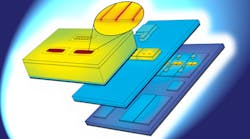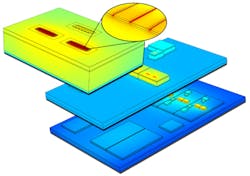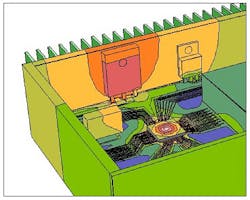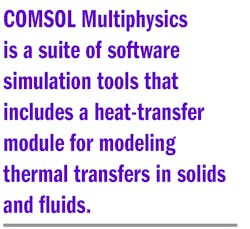This file type includes high resolution graphics and schematics when applicable.
1. The COMSOL Multiphysics suite of design software tools includes a thermal module with models for more than 2,500 different materials. (Image courtesy of Comsol)
Thermal modeling is becoming a more important part of the electronic design process, especially with increasing efforts to pack more power into smaller electronic devices. Quite simply, power = heat. Where power is generated or transferred, any form of loss will result in the production of heat. For the preservation of an electronic design, the heat must be efficiently removed. Thermal modeling is a way to predict where the heat comes from, how much must dissipated, and where it will go. Though typically less of a concern, thermal modeling can also be used to gauge the effects of colder temperatures on an electronic design.
Dissipating heat has long been an essential requirement in high-power systems, such as radar and communications transmitters. High-power components like amplifiers and antennas are usually surrounded by robust heat sinks made of thermally conductive metals to draw heat away from a source, such as a traveling wave tube (TWT) in a vacuum amplifier or the transistors in a solid-state amplifier.
Thermal management for these larger systems has relied on tried-and-true methods and heat sinks with well-established thermal profiles based on their material compositions. Metals like stainless steel and copper have the excellent thermal conductivity needed to provide a low-thermal-resistance path for the flow of heat away from the source, preventing the buildup of potentially damaging “hotspots” on the thermal source.
However, as the general trend in electronics is leading toward packing higher power levels into smaller package sizes, thermal management becomes more challenging, and thermal modeling becomes a more valuable tool in the design process. For example, with the increase of active devices based on gallium nitride (GaN) and GaN on silicon-carbide (GaN-on-SiC) transistor technologies, more high-frequency solid-state devices are available with higher power densities. This requires a combination of imaginative thermal modeling and precise thermal measurements to better understand how heat can best be removed from such high-power-density sources.
2. The SYMMIC thermal-analysis software provides templates for quick design of PCBs. (Image courtesy of CapeSym)
Heat can be removed from a source via three modes of heat transfer: radiation, convection, and conduction. Heat radiation from an area of high thermal energy to an area of lower thermal energy in an electronic design benefits from good air flow, often aided by a fan (although this is not a practical solution for miniature designs). Convection of heat involves the movement of fluids to transfer heat, such as in an automotive radiator. For smaller electronic designs, conduction—the flow of heat through solids—is the main method of removing heat from a source.
Developing thermal models for electronic circuits, devices, and their packages requires fundamental knowledge of the thermal resistances of the different materials used in these components, as well as other parameters related to thermal behavior. The latter includes the coefficients of thermal expansion (CTE) for different materials used in electronic design.
Printed-circuit-board (PCB) materials suppliers, for example, have invested significant time in understanding the thermal properties of the various dielectric materials that comprise their circuit materials, such as ceramic, fiberglass, and polytetrafluouroethylene (PTFE) materials, along with the thermal conductivities of metallization (such as copper) used to form the circuit traces on the PCBs. At higher power levels and densities, accurate knowledge of the thermal properties of each material, along with stress points at junctions between different materials, can provide insights into the behavior of the circuit materials over time and temperature.
In addition, since the dielectric constant of PCB materials changes as a function of temperature, circuit material developers typically model and measure their materials to precisely track the behavior of dielectric constant with temperature. Doing so enables circuit designers to incorporate that knowledge as part of their own circuit simulations.
Semiconductor-device developers have also investigated the thermal properties of the metal and semiconductor materials that comprise high-power-density devices, such as GaN and silicon-carbide (SiC) transistors. Special attention is paid to any material interfaces where thermal stresses may occur, since these interfaces can determine the ultimate reliability and lifetime of a semiconductor device at high power levels and densities.
Taking the Temperatures
Before a thermal model can be developed for any material or combination of materials, it is useful to know the amount of heat that will result under different operating conditions, which requires reliable thermal measurements. As electronic dimensions to be measured shrink in size, researchers grappling with developing thermal models face the challenges of performing accurate thermal measurements on micron-sized component features (e.g., transistor gates, drains, and sources).
The temperatures of electronic devices and circuits can be measured by contact or noncontact methods, although noncontact methods are usually preferred. Device developers have also incorporated built measurement tools into their designs, such as temperature-sensing diodes, to provide readings of temperature at or near the active device. However, external thermography systems are generally employed for reading the temperature of an active device and examining the effectiveness of circuit junctions, heat sinks, and packaging used along with that device to dissipate heat.
For example, infrared (IR) thermography can provide images of thermal gradients across the surface of a circuit or device, although it typically lacks the resolution needed to study hotspots in micron-sized areas. For thermal measurements on device-sized dimensions, Raman scattering has been widely used. In this process, the temperature of a micron-sized surface is studied by irradiating the surface with monochromatic light, and then gauging the temperature by amount of shift in the irradiated light reflected from the thermal source.
3. The Sauna thermal-modeling software can analyze thermal effects for individual components as well as full PCBs. (Image courtesy of Thermal Solutions Inc.)
Software tools for analyzing thermal effects have included 3D finite-element-analysis (FEA) electromagnetic (EM) simulation tools with thermal software modules, as well as dedicated thermal-analysis tools. Software using FEA predicts the mechanical effects of heat and thermal transfer on mechanical structures, including semiconductor-scale structures. Although FEA and thermal-analysis programs are sometimes considered competitive approaches to thermal analysis, they are complementary tools that can work well together to analyze thermomechanical stresses in electronic circuits and devices.
Some of the leading suites of RF/microwave design programs, such as the Advanced Design System (ADS) software from Keysight Technologies and CST Microwave Studio from Computer Simulation Technology, have been used in different ways for thermal analysis (e.g., analyzing current densities in active and passive components), although they lack nominal thermal-analysis programs.
One of the better-known software solutions for thermal analysis on the FEA side is FloTHERM from Mentor Graphics, which is readily integrated with electronic-design-automation (EDA) software tools for simultaneous modeling of circuit and device performance with thermal analysis. It clearly shows where different objects are connected in a design as well as all of the thermal interfaces, and includes an extensive device database. The thermal-modeling software can be used to predict thermal effects at the device, circuit, and system levels.
Long-time suppliers of high-frequency simulation tools like ANSYS, known for its FEA-based HFSS EM simulation software, have also developed software-analysis tools for thermal modeling. ANSYS’ Icepak can perform electronics cooling simulation and thermal analysis at chip-scale-package, circuit, and system levels. Like FloTHERM, Icepak is based on computation-fluid-dynamics (CFD) technology and simulation of heat flow according to fluid motion.
The CFD modeling approach is quite effective at predicting heat flow within a circuit or device, and how heat can be transferred from a thermal source. Icepak can provide thermomechanical stress analysis of active devices in different styles of packages, and can link to EM simulation software tools such as HFSS to study thermal effects on RF/microwave performance and EM behavior. EM analysis is combined with thermal analysis to predict reliability parameters—e.g., mean time to failure (MTTF).
COMSOL Multiphysics is a suite of software simulation tools that includes a heat-transfer module for modeling thermal transfers in solids and fluids (Fig. 1). Users gain the benefit of an extensive database of solids and fluids, with data or algebraic solutions for more than 2,500 different solid materials for thermal modeling. Users can also import thermodynamic and other material data from spreadsheets for creating their own thermal models. The Master RF Design Suite from CAD Design Software allows users to customize their combination of PCB software design tools, including a thermal-modeling module.
Developed specifically for thermal modeling, SYMMIC thermal-analysis software from CapeSym is an easy-to-use program for the design-stage thermal analysis of high-power RF/microwave components. It can be used to analyze the heat generation and dissipation from individual transistors, as well as from complete monolithic microwave integrated circuits (MMICs). The SYMMIC software can be integrated with popular commercial RF/microwave simulators like Microwave Office from AWR Corp. and the Advanced Design System (ADS) software from Keysight Technologies.
SYMMIC starts with predefined templates of active and passive devices in different circuit configurations that can be reconfigured to match a desired circuit layout (Fig. 2). The templates are based on 3D FEA heat-transfer studies and can be readily modified for the thermal analysis of many different MMIC parameters, including the orthopedic material properties, layer thicknesses, number of gates, channel dimensions, gate length, gate-to-gate spacing, and number and sizes of viaholes.
Thermal modeling and analysis need not be costly, as evidenced by the accessibility of the Sauna thermal-modeling software package from Thermal Solutions. Although the simple-to-use software is ideal for performing fast thermal analysis on circuit components such as heat sinks, it can also be used for thermal modeling of full PCB representations of a design on FR-4 and other circuit materials (Fig. 3).
Sauna includes a library of different standard pin and drop-in packages and package pad layouts, and allows a user to create custom packages for thermal modeling. The software contains 3D modeling capability to create any of the geometries and multilayer PCBs needed for transient thermal analysis, steady-state analysis, or thermal studies based on specific on/off duty cycles. As with a number of other thermal-modeling software tools, a free-of-charge evaluation software version of Sauna is available for a limited time.
This file type includes high resolution graphics and schematics when applicable.






